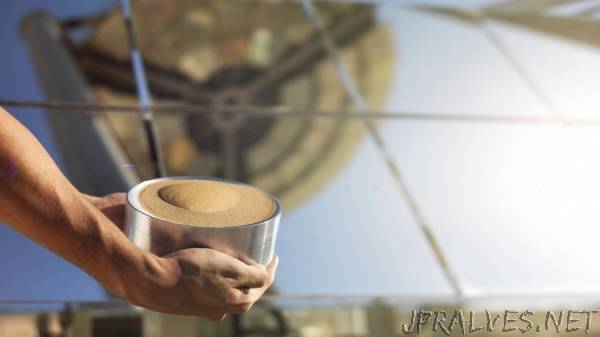
“Team Advances Exploration of UAE’s Sand as Thermal Energy Storage Material for Particle Solar Receiver Technology
A Khalifa University research team has taken another step towards unlocking the potential of the UAE’s sand as a thermal energy storage material with research showing the utilization of sand in a Direct Absorption Receiver (DAR) through an innovative gravity-fed solar receiver and storage system.
The ‘Sandstock’ project, launched by a research team at Masdar Institute in 2013, has the aim of utilizing the UAE’s sand in place of the molten salts typically used in Concentrated Solar Power (CSP) with storage systems. That research has explored the use of sand as a material that has a higher temperature tolerance than conventional thermal storage materials while also being more environmentally friendly and lower cost.
Earlier research by the team, led by Dr. Nicolas Calvet, Assistant Professor of Mechanical and Materials Engineering and Chair of the Masdar Institute Solar Platform (MISP), found that the UAE’s sand was thermally stable between approximately 650°C to 1000°C. Because conventional molten salt thermal energy storage media start to degrade at about 565°C, sand is a potentially more suitable thermal energy storage material than molten salt for high temperature Concentrated Solar Power (CSP). TES materials with high thermal stability can transfer significant heat to the working fluids that spin the turbines in CSP power plants and this makes for higher efficiency power plants.
The team’s latest research, published by PhD student Miguel Diago, EnergyNest Engineering Consultant Alberto Crespo Iniesta, French National Centre for Scientific Research CNRS Research Engineer Audrey Soum-Glaude, and Dr. Calvet in the journal Applied Energy, found that sand with a high concentration of calcium carbonate would be problematic in such a particle solar receiver and storage system because of agglomeration.
“The heated sand needs to flow smoothly through the system by gravity or in a fluidized bed, but when it has a high calcium carbonate concentration, it clumps,” Diago shared.
Sand is composed of insoluble minerals – basically tiny pieces of rock. Calcium carbonate in sand comes the shells and skeletons of marine organisms, like coral.
“The calcium carbonate content in the sand is related to the proximity to the sea: the closer you get, the higher the calcium content. We noticed that the best collection points were those far inland. In our case, the samples collected in the Liwa region were the least prone to agglomeration,” Diago explained.
The overall system in envisioned to work by focusing a concentrated beam of solar light onto a stream of flowing sand, heating it up to 1000°C. To recover the stored thermal energy from the sand, a heat exchanger is immersed into the heated sand, producing hot air or supercritical CO2 to power a gas turbine that produces electricity. The cooled sand is recycled for a continuous heat and discharge operation.
The team has previously completed analysis of sand samples from the UAE using X-ray fluorescence (XRF) and X-ray diffraction (XRD) techniques. These techniques have revealed the dominance of quartz and carbonate materials.
The next stage of the project is to build a large-scale solar receiver based on sand, and test it under the beam down solar concentrator at the Masdar Institute Solar Platform.”
